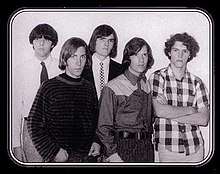Harbinger Complex
Harbinger Complex was an American garage rock/psychedelic rock band from Fremont, California, who were active in the mid-1960s. In the years since their breakup, their work has come to the attention of garage rock fans and collectors and has appeared on several retrospective compilations including the Nuggets 4-CD box set. They are best-remembered for their 1966 song, "I Think I'm Down."
Harbinger Complex | |
|---|---|
 | |
| Background information | |
| Origin | Fremont, California, United States |
| Genres | |
| Years active | 1963-1967 |
| Labels | Amber, Brent, Mainstream |
| Associated acts | The Baytovens |
| Past members |
|
History
The band began in 1963 in Fremont, California in the East Bay area, not far from San Francisco.[1][2][3] They were founded by Bob Hoyle III and Ron Rotarius, who had begun playing guitar together several years earlier when they were in the eighth grade.[1][4] The two continued to collaborate in high school, where, as sophomores, they recruited friends to put together a band called the Norsemen.[1][3] In 1965, Hoyle was called, as a Naval reservist, to active duty in Vietnam.[1] By the time he returned in 1966, the band, now called Harbinger Complex, had already been performing under the leadership of Rotarius.[1][2] Upon re-entering, Hoyle became the band's the band’s lead guitarist, while Rotarius went to rhythm guitar. During Hoyle's stint in Vietnam, the band had brought in Jim Hockstaff, known for his "Dionysian exploits," to become the group's lead singer and front man.[1][2] The other members were Gary Clark (bass), Jim Redding (drums), and Chuck Tedford (organ).[1] Tedford left the band shortly thereafter, and would not appear on any of the group's recordings.[1][3]
The band, who had developed a large following in Fremont, went to Golden State Records' studio to cut their first single released on the Amber label, “Time to Kill” b/w “When You Know You’re In Love” in April 1966.[1][5] These two songs, as with all of their subsequent recorded material, were written by Hockstaff and Hoyle (credited as "Hockstaff and Hoyle III").[1][2] Right around the time of their first single's release, they opened for Paul Revere & the Raiders, along with the Baytovens. In August 1966, the Harbinger Complex came out with their second single, “I Think I’m Down” b/w “My Dear and Kind Sir," which was released on the Brent label, and like the first was recorded at Golden State studios.[1][2][4] In late 1966 the band issued their third single, "Sometimes I Wonder" b/w "Tomorrow's Soul Sound," which was released on Amber Records, a partner-label to Brent. Jim Hockstaff left the band in early 1967, and Gary Clark took over on lead vocals thereafter.[1] Later that year, stereo and mono mixes of three of their previously released songs appeared on a various artists' compilation entitled, With Love: A Pot of Flowers, released by Mainstream Records, the parent label of Brent.[1][2][4][6] By the end of 1967 the band had broken up.[1] Bob Hoyle III died on May 6, 2003.[1]
Harbinger Complex's work has come to the attention of garage rock enthusiasts and collectors over the years and has been re-issued on several retrospective compilations, such as Mindrocker, Volume 10 and Nuggets, Vol. 12: Punk, Pt. 3. "I Think I'm Down" was included on the Nuggets 4-CD box set released in 1998 on Rhino Records.[2][4]
Membership
- Jim Hockstaff (lead vocals)
- Bob Hoyle III (lead guitar)
- Ron Rotarius (rhythm guitar)
- Gary Clark (bass)
- Chuck Tedford (organ)
- Jim Redding (drums)
Discography
- “Time to Kill” b/w “When You Know You’re In Love” (Amber 8999, April 1966)
- "I Think I'm Down" b/w "My Dear and Kind Sir" (Brent 7056, August 1966)
- "Sometimes I Wonder" b/w "Tomorrow's Soul Sound" (Amber 8999, 1966)
References
- Zolland, n/a (June 24, 2013). "The Harbinger Complex - Time to Kill (1966)". A Bit Like You and Me. A Bit Like You and Me. Retrieved October 18, 2015. - NOTE: Though the AllMusic bio. and certain other sources have the band's name printed with the definite article "The..." placed in front of the band's name, that does not square with the wording on the label for the Brent single, "I Think I'm Down," nor in flyers and press clippings (see Youtube videos for their reproduced photographs), which have the band's name presented without "The...". In 1966 it would have been the norm for the definite article to be placed in front of a band's name in most publications, unless a band and its management stipulated otherwise. So, this Wikipedia article must present their namesake according to the likelihood of how it actually was. The liner notes to Nuggets written by Mike Stax do not place a definite article in front of their name, and apparently they checked into the matter while researching the project.
- Montfichet, Stansted. "The Harbinger Complex: Artist Biography". Allmusic. AllMusic, a division of All Media Network, LLC. Retrieved October 18, 2015.
- Nipper, Mike (Nov 26, 2013). "It's November 26th, 2013 And You're in a Rad Garage Band - Harbinger Complex". The Stranger. Index Newspapers LLC. Retrieved October 18, 2015.
- Stax, Mike (1998). Nuggets: Original Artyfacts from the First Psychedelic Era 1965-1968 (4-Cd Box Set). Rhino Entertainment. p. 80.- "Optical Sound: The Technicolor Tales Behind the Various Nuggets" (track-by-track liner notes). Rhino Records R2 75466
- Markesich, Mike (2012). Teen Beat Mayhem (First ed.). Branford, Connecticut: Priceless Info Press. pp. 125. ISBN 978-0-9856482-5-1.
- Unterberger, Richie. "With Love: A Pot of Flowers". AllMusic. AllMusic, a division of All Media Network, LLC. Retrieved October 18, 2015.